The RMIT Centre for Urban Research is home to some of Melbourne's leading planning and sustainability academics driving the discussion on urban affairs.
Meet four urban experts contributing to the research and conversation that is changing how we plan and build healthy, equitable and liveable cities.
Planning new suburbs on the city fringe
Melbourne’s infrastructure is struggling to keep pace with current population growth.
New suburbs are expected to accommodate an extra half a million new homes over the next 35 years.
With scarce local employment and services, residents in outer suburbs can spend up to 15 or more hours per week commuting, with many travelling by car on congested roads as public transport is absent, unreliable or overcrowded.
Originally from Germany, urban and regional planner Dr Annette Kroen is investigating how both the public and private sectors can provide transport options to residents of Melbourne’s new suburbs as soon as they move in.
“It is critical to deliver efficient public transport and infrastructure including cycle-ways and footpaths, that supports public transport use and active transportation, early on in the lifetime of a suburb when behaviour change is greatest,” Kroen said.
“The project Early delivery of equitable and healthy transport options in new suburbs is very timely given the high growth rate Melbourne is currently experiencing.
“By bridging distances, transport provides an important function in peoples’ lives because it connects them to destinations such as employment, education, retail, recreational places, and other services which are critical for the health and economic wellbeing of people.”
Kroen is working with colleagues from across the Centre for Urban Research in collaboration with project partners from the Department of Transport, Planning Institute of Australia, Stockland Corporation, Victorian Planning Authority, Wyndham City and the City of Casey.
“The research will produce evidence of residents travel habits linking this to resident health outcomes not previously collected and analysed for Melbourne before,” Kroen said.
“By identifying ways to increase local transport options and improve mobility for residents in new suburbs from the start, we can improve individual and societal health benefits and equity among residents on the fringe.”
Creating healthy cities
Where we live has a huge influence on our health, yet that aspect is often excluded from major infrastructure and planning decisions.
Dr Lucy Gunn from the Healthy Liveable Cities Group based at the Centre for Urban Research knows the dangers of planning environments without considering health.
She is one of the many talents behind the national landmark project Creating Liveable Cities in Australia.
The project was the first of its kind to examine seven domains of a city’s liveability that promotes the health and wellbeing of Australians – walkability, public transport, public open spaces, housing affordability, employment and the food and alcohol environments.
“Much of my research is focused on the kinds of environments and the specific features within them that can support more physical activity and healthy behaviours, which can help reduce chronic diseases such as obesity, diabetes type 2 and some cancers,” Gunn said.
“I do this using survey data, and statistical and spatial mapping techniques – which help provide a strong quantitative and visual message for those with the power to enact change in how we build cities.
“Not just for health but also for environmental sustainability which is a by-product of creating healthy-cities.”
Gunn says she loves working in an interdisciplinary environment in collaboration with government and industry and is currently working on health economic evaluations of residential developments and exploring the value of walkable environments.
“I love that our research is being used by them to make big changes in how cities are designed and built that ultimately will affect every single one of us,” she said.
Investigating the benefits of urban greening
In Australia and around the world most of us live in urban areas and by 2050, 70% of the world’s population is predicted to live in cities and townships.
More than ever we need to plan and manage green spaces in cities that foster our health and wellbeing and contribute to social, cultural and environmental resilience.
Right now, there is a worldwide enthusiasm for bringing nature back to cities and incorporating greening into urban design with many studies finding positive impacts on our health and wellbeing.
Dr Leila Mahmoudi Farahani has long been interested in studying human-built environment interactions and understanding how the physical structure of cities and neighbourhoods impacts humans’ physiological and psychological comfort as well as their health and wellbeing.
As part of the People, Nature, Place program she is currently working on the Social Benefits of Urban Greening, establishing a network of integrated urban greening study sites to understand, quantify and qualify the multiple benefits of urban greening for biodiversity, human health and wellbeing.
The project will develop sampling protocols and approaches that can be used for different urban greening projects at a range of sites and scales.
“To know that my research impacts residents’ health and wellbeing and their quality of life is truly rewarding,” Mahmoudi Farahani, who came to Australia from Iran in 2013, said.
“I love engaging with communities and hearing their stories of how their home environment is impacting them in their everyday life.
“I also love the people I am working with and feel lucky to belong to an amazing group of colleagues at the centre, with a terrific gender diversity.”
Indigenous rights in urban planning
The connection between people and place is profound and central to everyday life for Indigenous people globally, in all their diversity.
Nearly 80% of Aboriginal and Torres Strait Islander people in Australia live in urban areas but cities often exclude and marginalise them.
Urban planning and policy have been central to this, and the harms can be seen in key moments and processes that have shaped Australia’s urban environments.
Scholar and activist Professor Libby Porter heads up the Critical Urban Governance program investigating the role of planning in delivering land justice for indigenous communities.
Her work has looked at these questions in a number of different ways including: Indigenous rights in urban planning and natural resource management; cities and diversity; gentrification and displacement; the impact of mega-events on cities; sustainability and urban governance.
“I'm interested in research that helps us understand injustice in all its forms, and what changes are necessary for us as a society to live more justly and sustainably on the planet,” Porter said.
“I'm especially interested in the forces that disconnect us from place, which means I'm often looking in my research at questions of dispossession, displacement, property rights and governance.”
Currently, Porter is working on research about non-Indigenous peoples' responsibility to Indigenous sovereignties, public housing redevelopment and its impacts, and stories about marginalised property.
“I love what I do because I get to work with so many different people on things that really matter to them in the world.”
Story: Chanel Bearder





